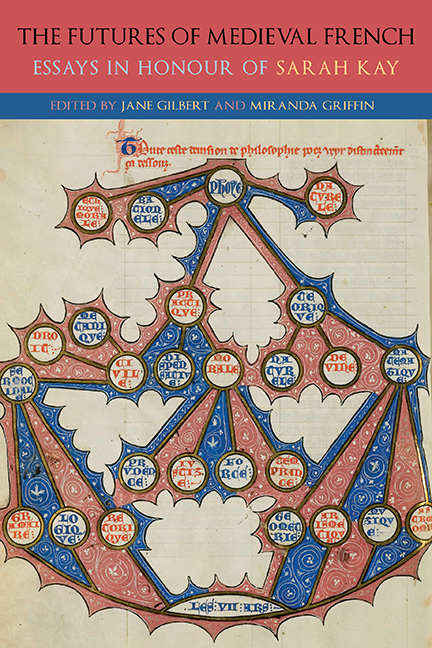Book contents
- Frontmatter
- Dedication
- Contents
- List of Illustrations
- List of Contributors
- List of Abbreviations
- Introduction
- Part I Subjectivity in Troubadour Poetry
- Part II The ‘Chansons de geste’ in the Age of Romance: Political Fictions
- Part III Courtly Contradictions: The Emergence of the Literary Object in the Twelfth Century
- Part IV The Place of Thought: The Complexity of One in French Didactic Literature
- Part V Parrots and Nightingales: Troubadour Quotations and the Development of European Poetry
- Part VI Animal Skins and the Reading Self in Medieval Latin and French Bestiaries
- Afterword
- General Bibliography
- List of Manuscripts
- Bibliography of Work by Sarah Kay
- Index
- Gallica
Third Gender Solace
Published online by Cambridge University Press: 27 May 2021
- Frontmatter
- Dedication
- Contents
- List of Illustrations
- List of Contributors
- List of Abbreviations
- Introduction
- Part I Subjectivity in Troubadour Poetry
- Part II The ‘Chansons de geste’ in the Age of Romance: Political Fictions
- Part III Courtly Contradictions: The Emergence of the Literary Object in the Twelfth Century
- Part IV The Place of Thought: The Complexity of One in French Didactic Literature
- Part V Parrots and Nightingales: Troubadour Quotations and the Development of European Poetry
- Part VI Animal Skins and the Reading Self in Medieval Latin and French Bestiaries
- Afterword
- General Bibliography
- List of Manuscripts
- Bibliography of Work by Sarah Kay
- Index
- Gallica
Summary
The three genders of male-authored troubadour poetry emerge here in their classic form: a ‘masculine’ subject of desire; a ‘feminine’ gender whose readiness to sate men's desire incurs their contempt; and a third, ‘mixed’ gender which assimilates the domna to ‘masculine’ norms, while continuing to represent her desirability as female.
(Subjectivity: 95)This kind of backward birthing mechanism makes the hunt for the roots of queerness a retrospective search for amalgamated forms of feelings, desires, and physical needs.
(Stockton 2009: 7)I BEGIN WITH TWO short quotations, one from Sarah Kay's Subjectivity in Troubadour Poetry that provides a taster of her critical bite and acumen; and another by Kathryn Bond Stockton, which, while targeting the backward turn sometimes required for queer self-recognition, also addresses a problem of historical methodology. How is one to learn about what was censured in the past other than by seeking out occluded expressions of feeling, abandoning narratives of growth and progress, bypassing the usual routes of social recognition – pretz and onor – and paying special attention to poetic forms that hide rather than expose such feelings, needs, and desires? These are not new questions: they were faced by feminist scholars in the 1970s and have resonated ever since; but they have taken on a new urgency in the twenty-first century as the gendered categories upon which so much feminist theory is based have come under renewed scrutiny.
Kay's simple suggestion of a third gender in troubadour song, a mixed gender that would appear only from distinct vantage points and from certain already established points of view, was a brilliant first step in recognising that the terms ‘men’ and ‘women’, ‘masculine’ and ‘feminine’, cannot be taken in troubadour song or elsewhere as self-evident. Much of gender theory, and later of queer and trans theory, has established that these categories depend for their integrity much more on structural positions and relations with power than on physiology, and that they move along a continuum upon which they coexist and overlap. In this essay, I will be re-examining this issue of occluded identity more closely, not to pronounce on men and women in the name of natural philosophy but to muddle those categories as much as the troubadours did, and to reveal that muddling as part of an ancient tradition that found rich expression in the medieval Occitan lyric.
- Type
- Chapter
- Information
- The Futures of Medieval FrenchEssays in Honour of Sarah Kay, pp. 19 - 33Publisher: Boydell & BrewerPrint publication year: 2021



